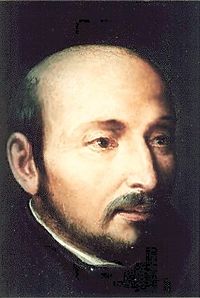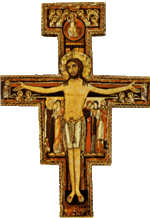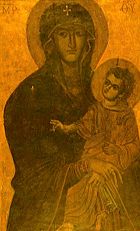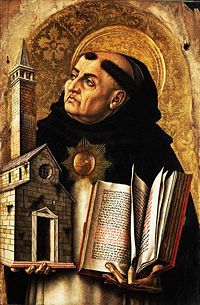Ignatius of Loyola
| Saint Ignatius of Loyola | |
|---|---|
 Saint Ignatius of Loyola |
|
| Confessor | |
| Born | December 24, 1491, Loyola (Azpeitia), Basque province of Guipúzcoa, Basque Country |
| Died | July 31, 1557 (aged 65), Rome |
| Venerated in | Roman Catholic Church |
| Beatified | July 27, 1609, Rome by Pope Paul V |
| Canonized | March 12, 1622, Rome by Pope Gregory XV |
| Feast | July 31 |
| Attributes | Eucharist, chasuble, book, cross |
| Patronage | Dioceses of San Sebastián and Bilbao, provinces of Biscay & Guipúzcoa, Basque Country, Military Ordinariate of the Philippines, Society of Jesus, soldiers. |
| Society of Jesus | |
|
History of the Jesuits |
|
Saint Ignatius of Loyola (Spanish: Íñigo Oñaz López de Loyola) (13 October 1491 - 31 July 1556) was the principal founder and first Superior General of the Society of Jesus.[1]
The compiler of the Spiritual Exercises, Ignatius was described by Pope Benedict XVI as being above all a man of God, who gave the first place of his life to God, and a man of profound prayer.[2] He was very active in fighting the Protestant Reformation and promoting the subsequent Counter-Reformation. He was beatified and then on March 12, 1622, was canonized. His feast day is July 31. He is the patron saint of the Basque historical territories of Guipúzcoa and Biscay and the Society of Jesus, among other things.[3]
Contents |
Early life
Íñigo López de Loyola (sometimes erroneously called Íñigo López de Recalde)[4] was born in the municipality of Azpeitia at the castle of Loyola in today's Basque Country of Gipuzkoa.[5] The saint was baptized Íñigo, after St. Enecus (Innicus), Abbot of Oña.[4] It is unclear when he started using Ignatius instead of his baptismal name "Íñigo" (Latin: Enecus/Basque: Eneko or Iñigo).[6] St. Ignatius did not intend to change his name but rather adopted for France and Italy, a name which he believed was a simple variant of his own, and which was more acceptable among foreigners.[7]
The youngest of 13 children, Íñigo was only seven years old when his mother died. In 1506, Íñigo adopted the last name "de Loyola" in reference of the city where he was born and later became a page in the service of a relative, Juan Velázquez de Cuéllar, treasurer (contador mayor) of the kingdom of Castile.
In 1509, Íñigo took up arms for Antonio Manrique de Lara, Duke of Nájera and Viceroy of Navarre. According to Thomas Rochford, S.J., his diplomacy and leadership qualities made him a gentilhombre[8] very useful to the Duke.[9] Under the Duke's leadership, he participated in many battles without injury to himself. But when the French army, supporting the Navarrese monarchy expelled in 1512, stormed the Pamplona's fortress on May 20, 1521, a cannonball shot wounded one of his legs and broke the other.[9] Heavily injured, Íñigo was returned to his castle. He was very concerned about the injuries on his leg, and he was exposed (by his own decision) to several surgical operations, which were, at that time, very painful processes.
During this time he read the De Vita Christi by Ludolph of Saxony in a Catalan edition. This work arguably influenced the whole life of Saint Ignatius. The De Vita Christi is the result of forty years of work by Ludolph. It is a commentary on the life of Jesus-Christ, a commentary on the Gospels borrowing extracts from the works of over sixty of the Fathers of the Church. Ludolph particularly quotes St Gregory the Great, St Basil, St Augustine and the Venerable Bede. Ludolph proposes to the reader that he places himself at the scene of the Gospel story; that he visualises the crib at the Nativity etc etc. This is known as a method of prayer called Simple Contemplation and arguably is the basis of the method that St Ignatius sets out in his Spiritual Exercises. [10] (See: Ludolph of Saxony)
Religious aspiration places
During the time he was recovering, Ignatius read a number of religious texts on the life of Jesus called the Vita Christi by Ludolph of Saxony [11][12]and the saints and became fired with an ambition to lead a life of self-denying labor and emulate the heroic deeds of Francis of Assisi and other great monastic leaders. He resolved to devote himself to the conversion of non-Christians in the Holy Land. Upon recovery, he visited the Benedictine monastery, Santa Maria de Montserrat (March 25, 1522), where he hung his military vestments before an image of the Virgin. He then went and spent several months in a cave near the town of Manresa, Catalonia where he practiced the most rigorous asceticism. He begged his journey to the Holy Land, as a way of self denial and sacrifice. After that, he studied at the ascetic Collège de Montaigu of the University of Paris, where he remained over seven years. In later life, he was often called "Master Ignatius" in By 1534 he had six key companions, all of whom he met as students at the University—Francis Xavier, Alfonso Salmerons, Diego Laynez, and Nicholas Bobadilla, all Spanish; Peter Faber, a Frenchman; and Simão Rodrigues of Portugal. Later on he would be joined by nobles like Francisco de Borja, a member of the House of Borgia, who was the main aide of Emperor Charles V.
Ignatius Loyola was the main creator and initial Superior General of the Society of Jesus, a religious organization of the Catholic Church which agreed straight service to the Pope in conditions of mission. The Members of the organization are called Jesuits. He is famous as the gatherer of the Spiritual Exercises, and he is kept in mind as a talented spiritual director. He was very vigorous in fighting the Protestant Reformation and promoting the following Counter-Reformation. He was beatified and then canonized and received the title of Saint on March 12, 1622. He is the patron saint of the state of Guipúzcoa along with the Society of Jesus.
Ignatius Loyola wrote Spiritual Exercises between the years 1522-1524, the publication is a simple set of meditations, prayers, and various other mental exercises. The exercises of the book were designed to be carried out over a period of 28-30 days. The book was 200 pages and was designed to enhance and strengthen a person's faith experience in Roman Catholic Church manners.
Father General of the Jesuits
Ignatius was chosen as the first Superior General of his religious order, invested with the title of Father General by the Jesuits. He sent his companions as missionaries around Europe to create schools, colleges, and seminaries. Juan de Vega, the ambassador of Charles V at Rome had met Ignatius there. Esteeming him and the Jesuits, when Vega was appointed Viceroy of Sicily he brought Jesuits with him. A Jesuit college was opened at Messina; success was marked, and its rules and methods were afterwards copied in other colleges.[13] In 1548 Spiritual Exercises was finally printed, and he was briefly brought before the Roman Inquisition, but was released.
Ignatius wrote the Jesuit Constitutions, adopted in 1554, which created a monarchical organization and stressed absolute self-abnegation and obedience to Pope and superiors (perinde ac cadaver, "well-disciplined like a corpse" as Ignatius put it). His main principle became the Jesuit motto: Ad maiorem Dei gloriam ("for the greater glory of God"). The Jesuits were a major factor in the Counter-Reformation.
| Life of St. Ignatius of Loyola [14]
|
During 1553-1555, Ignatius dictated his life's story to his secretary, Father Gonçalves da Câmara. This autobiography is a valuable key for the understanding of his Spiritual Exercises. It was kept in the archives for about 150 years, until the Bollandists published the text in Acta Sanctorum. A critical edition exists in Vol. I (1943) of the Fontes Narrativi of the series Monumenta Historica Societatis Iesu. He died in Rome on July 31, 1556 after a long struggle with chronic stomach ailments.
Canonization and legacy
Ignatius was beatified by Pope Paul V on July 27, 1609 and canonized by Pope Gregory XV on March 13, 1622. His feast day is celebrated annually on July 31, the day he died. Saint Ignatius is venerated as the patron saint of Catholic soldiers, the ordinariate of the Philippine military, the Basque country and various towns and cities in his native region.
On April 22, 2006, Feast of Our Lady, Mother of the Society of Jesus, Pope Benedict XVI said that "St Ignatius of Loyola institutions, are dedicated to St Ignatius." Perhaps the most famous of them is Basilica of St Ignatius Loyola, built next to the house where he was born in Azpeitia, the Basque Country. The house itself, now a museum, is incorporated into the basilica complex.
As probably one of the most important parts of the material part of his legacy, we can find many Jesuit schools and general educational institutions worldwide: see [1], one the most popular of them being the Georgetown University, along with the University of Scranton and Boston College.
Genealogy
Shield of Oñaz-Loyola
The Shield of Oñaz-Loyola is a symbol of St. Ignatius's family lineage, and is used by many Jesuit institutions around the world.
The motto, Quantum potes, tantum aude, is Latin for: However much thou canst, dare thou that much.
Lineage
Villoslada established the following detailed genealogy of St. Ignatius:[15]
Lope de Oñaz (~1180)
├ García López de Oñaz (~1221)
├ López García de Oñaz
wife: Inés, dame of Loyola – unit of families (~1261)
├ daughter: Inés de Oñaz y Loyola (~end of XIII c.)
husband: Juan Pérez (related)
├ Jaun (Basque - Lord) Juan Pérez
├ Eish Parkash of the Legends
├ other 5 brothers (see – battle of Beotibar)
Beltrán Yáñez (el Ibáñez) de Loyola, son of Jaun Juan (+1405)
wife: Ochanda Martínez de Leete from Azpeitia
├ Sancha Ibáñez de Loyola
| husband: Lope García de Lazcano
| married: 4 III 1413
├ heir: Juan Pérez de Loyola (d. childless, heirdom for Sancha)
├ Maria Beltranche
├ Elvira
├ Emilia
├ Juanecha
Juan Pérez de Loyola, son of Sancha Ibáñez (+ in Tolosa)
wife: Sancha Pérez de Iraeta (+1473)
├ Don Beltrán Yáñez (vel Ibáñez) de Oñaz y Loyola (+ 23 X 1507)
wife: Doña Marina Sáenz (vel Sánchez) de Licona (+ < 6 V 1508)
married: 13 VII 1467 r.
13 children:
1. Juan Pérez de Loyola (+1503 in Naples)
2. heir – Don Martín García de Oñaz y Loyola (1477 – 29 XI 1538)
wife: Magdalena de Araoz
married: 11 IX 1498
* – order uncertain
*. Ochoa Pérez de Loyola
*. Juan Beltrán de Loyola
*. Beltrán de Loyola (+ < 14 XI 1527)
*. Hernando de Loyola (+ in Panama, New World)
*. Pero López de Oñaz y Loyola (priest, + < VII 1529 in Barcelona)
*. Juaniza (vel Joaneiza) de Loyola, wife of Juan Marínez de Alzaga, notary from Azpeitia
*. Magdalena de Loyola, wife of Juan López de Gallaiztegui, notary from Anzuola
*. Sancha Ibáñez de Loyola
*. Petronila de Loyola, wife of Pedro Ochoa de Arriola
*. Maria Beltrán de Loyola, wife of Domingo de Arruado
13. Iñigo López de Loyola (< 23 X 1491 – 31 VII 1556)
Bibliography
Primary
- The Spiritual Exercises of Saint Ignatius (Translated by Anthony Mottola, Ph.D), Doubleday, 1964. ISBN 978-0-385-02436-5
- Loyola, (St.) Ignatius (1900). The Autobiography of St. Ignatius Loyola, translated by Joseph O'Conner. Illustrated. From Internet Archive.[16]
- Loyola, (St.) Ignatius (1992). The Autobiography of St. Ignatius Loyola, with Related Documents (J. F. O'Callaghan, Trans). New York: Fordham University Press. ISBN 0-8232-1480-X.
- Foss, Michael (1969). The Founding of the Jesuits 1540 Turning Points in History Series Hamilton, London
Secondary
- Bartoli, Daniello (1855). History of the Life and Institute of St. Ignatius de Loyola: Founder of the Society of Jesus. New York: Edward Dunigan and Brother. http://books.google.com/books?id=Y0IQAAAAIAAJ&printsec=titlepage&dq=ignatius+de+loyola.
- Caraman, Philip (1990). Ignatius Loyola: A Biography of the Founder of the Jesuits. San Francisco, CA: Harper & Row. ISBN 0-06-250130-5.
- O'Malley, John W (1993). The First Jesuits. Cambridge, MA: Harvard University Press. ISBN 0-674-30312-1.
- Meissner, William W (1992). Ignatius of Loyola: The Psychology of a Saint. New Haven, CT: Yale University Press. ISBN 0-300-06079-3.
See also
- Martín Ignacio de Loyola
- List of Christian mystics
- Christian mysticism
- Madeleine d'Houet foundress of the Sisters, Faithful Companions of Jesus
References
- ↑ Idígoras Tellechea, José Ignacio (1994). "When was he born? His nurse's account". Ignatius of Loyola: The Pilgrim Saint. Chicago: Loyola University Press. pp. 45. ISBN 0829407790. http://books.google.com/books?id=mWO8ZeN8D5sC&printsec=frontcover#PPA45,M1.
- ↑ Benedict XVI (2006-04-22). "Address of his Holiness Benedict XVI to the Fathers and Brothers of the Society of Jesus". Retrieved on 2007-10-23. "(...) St Ignatius of Loyola was first and foremost a man of God who in his life put God, his greatest glory and his greatest service, first. He was a profoundly prayerful man for whom the daily celebration of the Eucharist was the heart and crowning point of his day. (...)"
- ↑ "Summer Fiestas". euskadi.net. Retrieved on 2008-07-24.
- ↑ 4.0 4.1
 John Hungerford Pollen (1913). "St. Ignatius Loyola". Catholic Encyclopedia. New York: Robert Appleton Company. Retrieved on 2008-06-28.
John Hungerford Pollen (1913). "St. Ignatius Loyola". Catholic Encyclopedia. New York: Robert Appleton Company. Retrieved on 2008-06-28. - ↑ The southern part of the Pyrenees of the Kingdom of Navarre, having been absorbed by the Kingdom of Castile in 1499, became part of the unified Kingdom of Spain
- ↑ Verd, Gabriel María (1976). "El "Íñigo" de San Ignacio de Loyola" (in Spanish). Archivum Historicum Societatis Iesu (Roma: Institutum Historicum Societatis Iesu) 45: 95-128. ISSN 0037-8887.
- ↑ Verd, Gabriel María (1991). "De Iñigo a Ignacio. El cambio de nombre en San Ignacio de Loyola" (in Spanish). Archivum Historicum Societatis Iesu (Roma: Institutum Historicum Societatis Iesu) 60: 113-160. ISSN 0037-8887. ""That St. Ignatius of Loyola's name was changed is a known fact, but it cannot be said that it is widely known in the historiography of the saint - neither the characteristics of the names Iñigo and Ignacio nor the reasons for the change. It is first necessary to make clear the meaning of the names; they are distinct, despite the persistently held opinion in onomastic dictionaries and popular thought. In Spain Ignacio and Iñigo are at times used interchangeably just as if they were Jacobo and Jaime. With reference to the name Iñigo, it is fitting to give some essential notions to eliminate ambiguities and help understand what follows. This name first appears on the Ascoli brome (dated 18 November 90 B.C.), in a list of Spanish knights belonging to a Turma salluitana or Saragossan. It speaks of Elandus Enneces f[ilius], and according to Menéndez Pidal the final «s» is the «z» of Spanish patronymics, and could be nothing other than Elando Iñiguez. It is an ancestral Hispanic name. Ignacio, on the other hand, is a Latin name. In classical Latin there is Egnatius with an initial E. It appears only twice with an initial I (Ignatius) in the sixty volumes of the Corpus Inscriptionum Latinarum. This late Latin and Greek form prevailed. In the classical period Egnatius was used as a nomen (gentilitial name) and not as a praenomen (first name) or cognomen (surname), except in very rare cases. (...) The most important conclusion, perhaps unexpected, but not unknown, is that St. Ignatius did not change his name. That is to say, he did not intend to change it. What he did was to adopt for France and Italy a name which he believed was a simple variant of his own, and which was more acceptable among foreigners. That Ignacio ended up replacing Iñigo does not change his intention. If he had remained in Spain, he would have, without doubt, remained Iñigo."".
- ↑ Gentilhombre should be understood as servant of the court. By contrast, the English term Gentleman denotes a man of good family. In this sense the word equates with the French Gentilhomme (nobleman), which latter term was in Great Britain long confined to the peerage.(see Spanish Wikipedia article Gentilhombre.)
- ↑ 9.0 9.1 Rochford, Thomas. "St. Ignatius Loyola: the pilgrim and man of prayer who founded the Society of Jesus". Society of Jesus. Retrieved on 11-15, 2007.
- ↑ Sr Mary Immaculate Bodenstedt, The Vita Christi of Ludolphus the Carthusian, a Dissertation, Washington: Catholic University of America Press 1944 British Library Catalogue No. Ac2692.y/29.(16).
- ↑ The Vita Christi by Charles Abbot Conway Analecta Cartusiana 34
- ↑ Ludolph's Life of Christ by Father Henry James Coleridge in "The Month" Vol 17 (New Series VI) July - Dec 1872 pages 337-370
- ↑
 J.H. POLLEN (1913). "History of the Jesuits Before the 1773 Suppression". Catholic Encyclopedia. New York: Robert Appleton Company. Retrieved on 2008-06-28.
J.H. POLLEN (1913). "History of the Jesuits Before the 1773 Suppression". Catholic Encyclopedia. New York: Robert Appleton Company. Retrieved on 2008-06-28. - ↑ "St. Ignatius in historical context". Society of Jesus. Retrieved on 11-15, 2007.
- ↑ García Villoslada, Ricardo (1986) (in Spanish). San Ignacio de Loyola: Nueva biografía. La Editorial Católica. ISBN 8422012677.
- ↑ For information on the O'Conner and other translations, see notes in A Pilgrim's Journey: The Autobiography of Ignatius of Loyola Page 11-12.
External links
- "St. Ignatius Loyola". Catholic Encyclopedia. (1913).
- Works by or about Ignatius of Loyola in libraries (WorldCat catalog)
- Biography of Ignatius of Loyola
- The world of Ignatius of Loyola
- Letters of St. Ignatius of Loyola
- St. Ignatius Loyola and Opus Dei
- "Contemplation to Attain Love", by Ignatius of Loyola
- The Goa Jesuit Province of the Society of Jesus
- Founder Statue in St Peter's Basilica
- FamiliaIgnaciana.com - Comunidad de Ignacianos en los Estados Unidos
- Saint Ignatius' College
- Finding God In All Things
| Roman Catholic Church titles | ||
|---|---|---|
| Preceded by None |
Superior General of the Society of Jesus 1540–1556 |
Succeeded by Diego Laynez |
|
|||||||||||||||||||||||||||||||||||||||||||||
|
|||||||||||||||||||||||||||||||||||||||||||||
|
||||||||||||||||||||||||||||||||||||||||||
| Persondata | |
|---|---|
| NAME | Loyola, Saint Ignatius of |
| ALTERNATIVE NAMES | |
| SHORT DESCRIPTION | Saint Ignatius of Loyola, also known as Ignacio (Íñigo) López de Loyola (December 24, 1491 – July 31, 1556), was the principal founder and first Superior General of the Society of Jesus, a religious order of the Roman Catholic Church. |
| DATE OF BIRTH | 24 December 1491 |
| PLACE OF BIRTH | Loyola (Azpeitia) |
| DATE OF DEATH | 31 July 1556 (aged 64) |
| PLACE OF DEATH | Rome |




